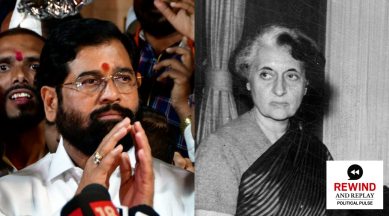Shiv Sena name, symbol dispute, and a 1969-71 Congress parallel
Congress saw the split over Indira Gandhi's defiance of the old guard to prop up own candidate for President post; her faction got the party name, Congress (O) got the old symbol

Challenging the Election Commission order recognising the Eknath Shinde faction as the real Shiv Sena, and allotting it the party symbol of ‘bow and arrow’, Uddhav Thackeray Monday demanded that the poll panel be dissolved. He also claimed that “there was not a single instance where the party name and symbol were directly given to one faction”.
What happened during the first such instance?
The Election Symbols Order, 1968, of the EC deals with the question of a split in a political party outside of the Legislature. The first case under the order was the fissure of the Indian National Congress in 1969. At the time, while the Congress group led by Indira Gandhi was recognised as the Congress party and given a new symbol, the Congress (O) retained the old symbol.
The Congress split
Prime Minister Indira Gandhi’s tensions with a rival group within the party came to a head with the death of President Dr Zakir Hussain on May 3, 1969.
The Congress old guard, led by K Kamaraj, Neelam Sanjiva Reddy, S Nijalingappa and Atulya Ghosh, known as the Syndicate, nominated Reddy for the post. Indira Gandhi, however, encouraged Vice-President V V Giri to contest as an Independent, and called for a “conscience vote” in defiance of the whip issued by party president Nijalingappa.
After Giri won, Indira Gandhi was expelled from the Congress, and the party split into the “old” Congress, or Congress (O), led by Nijalingappa, and the “new” Congress led by Indira Gandhi. The “old” Congress retained the party’s symbol of a pair of bullocks carrying a yoke; the breakaway faction was given the symbol of a cow with its calf.
The Election Commission order
A case summary on the EC website detailing how the Indira Gandhi group was recognised as “the Indian National Congress”, says: “The Indian National Congress is a recognised National Party under the provisions of the Election Symbols (Reservation and Allotment) Order, 1968. There was a split in that party in 1969, resulting in the formation of two groups, led by Shri Jagjivan Ram and Shri Nijalingappa respectively.
“As each group contended that it was the party, the Election Commission adjudicated the dispute between the two rival groups of the party under para 15 of the said Order. After recording the evidence and hearing detailed submissions of both the groups, the Commission came to the conclusion that the group led by Shri Jagjivan Ram enjoyed the majority support, both in the organisational and Legislature wings of the party, and, consequently, recognised that group as the Indian National Congress, by its order dated 11.1.1971.”
The order says it was “found that the group presided over by Jagjivan Ram had the majority out of the total number of members returned on Congress tickets to the House of Parliament as well as the majority out of the sum total of the members of all Legislatures returned on Congress tickets”.
As far as the organisational wing was concerned, the EC came to the conclusion that the Jagjivan Ram group also enjoyed a majority in the All India Congress Committee as well as amongst the delegates of the undivided Congress.
In para 32 of the order, the EC adds: “It is not permissible to dissect the (old) symbol and give one out of the two bullocks represented in the symbol to one group and the other bullock to the other group as the symbol is not a property to be divided between co-owners.”
Case went to the Supreme Court
The EC order adds that the “aggrieved” Nijalingappa group filed an appeal before the Supreme Court. The Court, however, upheld the order of the EC, saying, “the test of majority or numerical strength applied by the Commission for determining the dispute was a relevant and valuable test, and rightly applied by the Commission”.
This came to be referred to as the Sadiq Ali judgment and the EC cited it in its order in the Shiv Sena case on February 17.
The Uddhav Thackeray Sena has also moved the Supreme Court against the EC move.
Incidentally, in the Sena case, the EC held an amendment to the party constitution in 2018 as “undemocratic”, adding that since the details of the party’s organisational structure were not mentioned by either of the factions, proving the test of majority in the organisational structure was inconclusive. Hence, the EC relied upon the test of majority in the legislative wing of the party, in which the Shinde faction had the numbers.